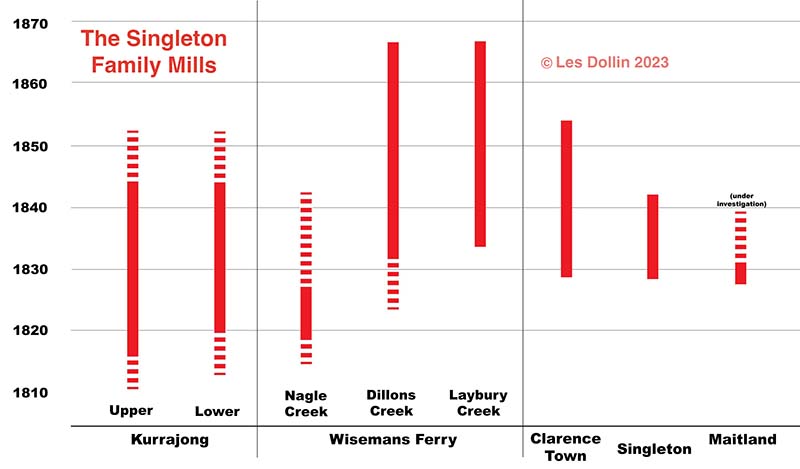
Overview of the Singleton Mills
Singleton Mills homepage > Overview of the Singleton Mills
Brothers, Benjamin and James Singleton, established eight pioneering water-powered flour mills in New South Wales in the early 1800s, assisted by their brother, Joseph. This chart is a guide to the locations of these mills and their years of operation:

.
For many mills, their dates of establishment or closure have not been found in the surviving historical records so far. For example, the first record found for a mill might be from when it had been operating for some years. In these cases, we have indicated the uncertain dates with dashed lines.
Nevertheless, the chart shows that the family established water-powered mills from the early 1810s to the mid 1830s and that many of these mills operated successfully for decades.
It should be pointed out that the Singleton family did not own or run all of these mills throughout the years they operated:
-- Sometimes a family member of the Singletons would operate the mill. For instance, James Singleton's step-son, Thomas Green, was operating the Dillons Creek Mill in 1833. This mill at that time was called Green's Mill, even though James Singleton still owned the land where it stood.
-- Sometimes, after a mill was fully operational, the Singleton owner would mortgage or sell it, to raise funds to build other mills or for other ventures. Then the mill might be operated by a new owner, or leased out to another miller.
Benjamin Singleton owned the land where the watermills at Kurrajong, Clarence Town, Singleton, and probably Maitland, were established. He probably played a leading role in the establishment of these mills.
James Singleton owned the land where the three Wisemans Ferry watermills were established and probably was the key figure for these mills.
To read more about these eight water-powered flour mills, visit:
-- Upper Mill, Kurrajong
-- Lower Mill, Kurrajong
-- Nagle Creek, Wisemans Ferry area
-- Dillons Creek, Wisemans Ferry area
-- Layburys Creek, Wisemans Ferry area
-- Clarence Town
-- Singleton
-- Maitland.
The new technology of steam-power began to be used for flour mills in later years. Newspaper records show that the Singleton Family also built at least three steam-powered flour mills in the mid 1800s.
Further Reading
• Types of Mills • Watermills in creeks vs Tidal Mills